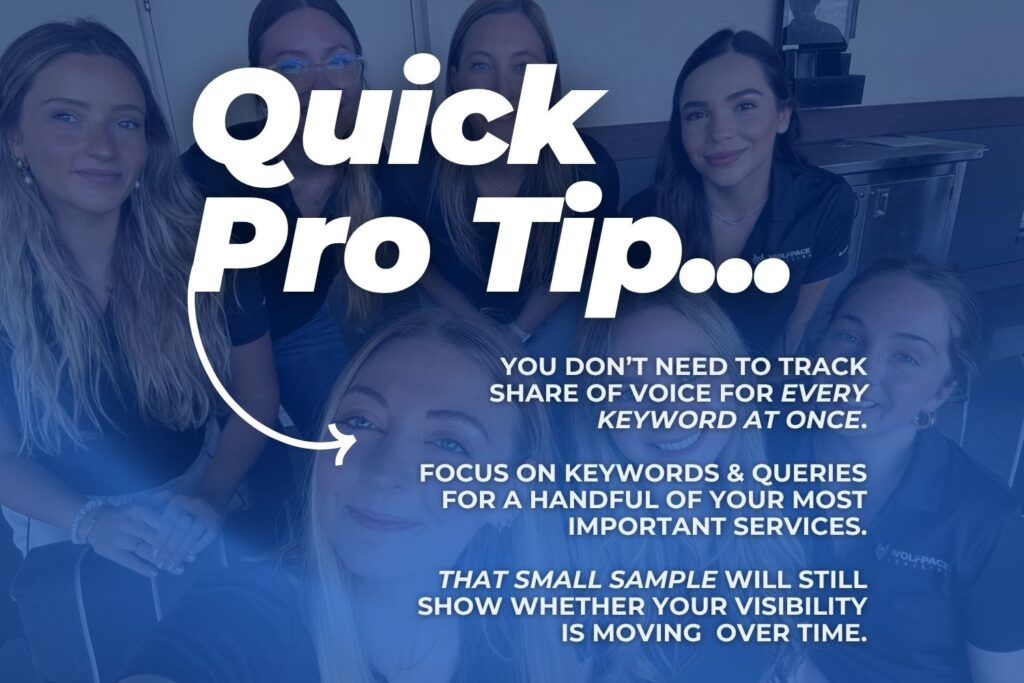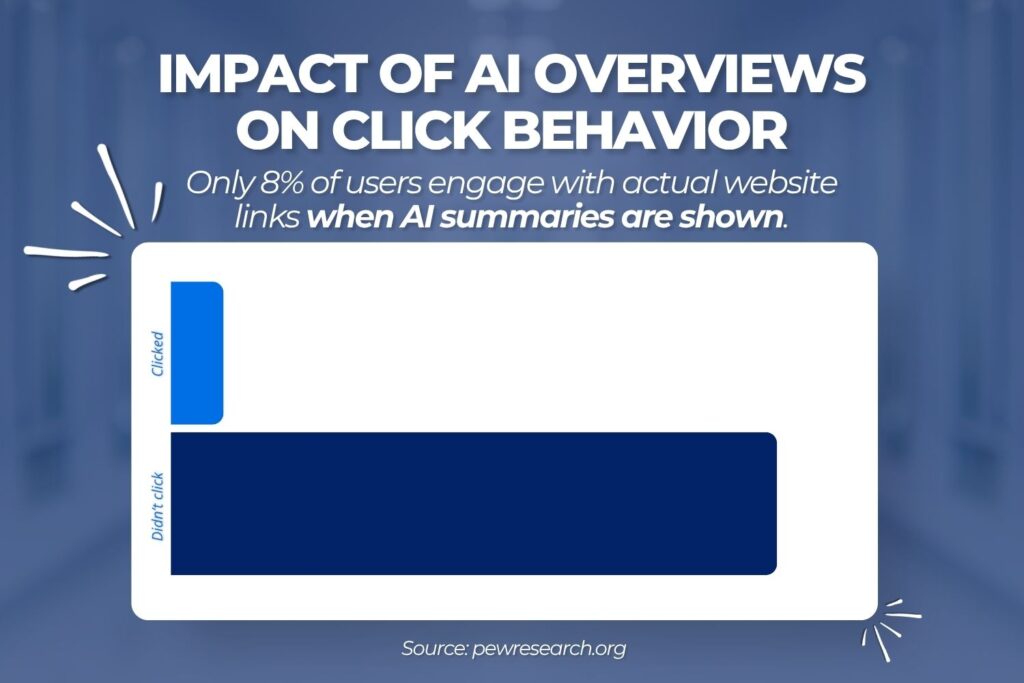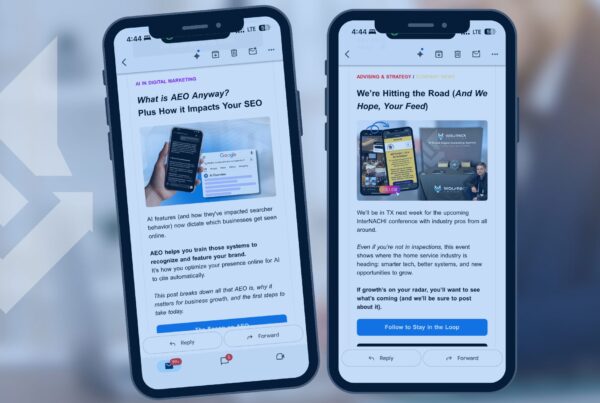Last updated on October 31st, 2025 at 11:54 am
Your SEO share of voice is a simple way to understand how much visibility your brand has compared to competitors. It tells you what percent of the search landscape you actually own.
But today, with AI overviews and other bot-driven answers appearing in engines like Google or ChatGPT, the share of voice now includes whether your business shows up in those results, too.
Think of it as your online market share of attention. If competitors dominate more of the space, they’ll earn more clicks, more trust, and more customers.
Contents
What Does Share of Voice Really Mean?
Share of voice is essentially the measure of how visible you are compared to everyone else, wherever people are searching.

In the past, marketers used this term for ad spend, but it has come to revolve around search and visibility.
- SEO share of voice: This shows how often your business appears in search results across a group of keywords that matter to you. If you’re consistently ranking at the top for those terms, your share of voice is strong.
- AI share of voice: This covers how often your business is cited or recommended in AI-generated answers. For example, if a homeowner searches “how to spot termites” and Google’s AI Overview pulls from your blog post, you’ve gained AI visibility.
Why does this matter? Only 8% of users engage with actual website links when AI summaries are shown.
So basically, people now trust AI summaries and featured results as much as, if not more than, scrolling through all the links.
That means that both SEO and AI share of voice are critical measures of your real visibility online.
| Type | What It Measures | How to Track | Why It Matters |
|---|---|---|---|
| SEO Share of Voice | Visibility across search rankings for target keywords | SEMrush, Ahrefs, Google Search Console | Shows how much of the SERPs you own |
| AI Share of Voice | Mentions in AI-generated answers (Google AI Overviews, ChatGPT, Perplexity) | Manual tracking or AI monitoring tools | Shows how often you’re trusted by AI tools |
Why Does Share of Voice Matter for Your Business?
Visibility equals opportunity. The more often people see your business in search and AI results, the more likely they are to visit your site, call your office, or book a service.
Here’s a bite-sized look at why share of voice matters:
- Competitive benchmark: It reveals whether you’re keeping pace with competitors in your market or losing ground.
- Authority signal: When your business consistently shows up in both search and AI answers, people start to see you as the trusted choice.
- Local impact: For service businesses, even small increases in visibility can translate into steady lead flow. For example, ranking above another inspector for “home inspection near me” could mean dozens of extra calls each month.
According to industry studies, the first three organic results in Google capture over 50% of all clicks. If you’re not visible there, you’re losing out to whoever is.
How Do You Measure Share of Voice in SEO and AI Results?
Measuring share of voice is really about answering one question: How often does my business show up compared to others when people search for my services?
Here’s a simple way to track it:
For SEO (search results):
- Make a list of the top keywords tied to your services (like “home inspection near me” or “termite treatment cost”).
- Use free tools like Google Search Console, or paid ones like SEMrush or Ahrefs, to see where you rank for those terms.
- Pay attention to whether you show up for your brand name (branded searches) and also for services people don’t yet connect with you (non-branded searches). Both matter, but non-branded searches usually bring in new customers.
For AI results (AI overviews and summaries):
- Type your service-related questions into Google and see if your business or website is included in the AI overview box.
- Try the same in ChatGPT or Perplexity to check if your business, blog, or service pages are mentioned.
- Write down where you show up and where competitors appear.
So, how often should you check in? For most service businesses, once a month is enough. The key is to track consistently, so you can see whether your visibility is growing or shrinking over time.
How Can You Increase Share of Voice in SEO and AI Results?
A growing share of voice means building authority and making your business the one that search engines and AI tools want to highlight. Here are core ways to do it:

1. Target intent-driven keywords
Focus on queries your customers actually type or ask out loud. Examples: “How much does a quarterly pest control plan cost?” or “Signs of a cracked foundation.”
These terms connect directly to the services you provide, but make sure to validate them with keyword research tools like SEMrush, Ahrefs, or Google Keyword Planner!
Relying only on what seems relevant to you right now can mean glossing over what people are actually searching for, or writing for a keyword you’ll never rank for.
2. Build content clusters
Instead of publishing isolated blogs, connect them to core service pages. A content cluster starts with a main page (such as “Termite Treatment”) and then branches into supporting posts that cover related topics in depth.
For example:
- Service page: Termite Treatment
- Supporting blogs: How to identify termite frass, seasonal risks for termite infestations, prevention, and treatment options
This structure creates a “web” of information that signals topical authority.
Google recognizes that you cover the subject thoroughly, and AI tools are more likely to pull from your content when generating answers because it reflects depth and expertise.
3. Optimize All Content for AI results
AI-generated answers that searchers see will rely on clear, trustworthy, and structured information (from you).
To increase the chance of being cited:
- Write direct, concise answers to common questions within your content
- Use schema markup and structured data so machines can interpret your pages accurately
- Include trustworthy sources, statistics, or examples that reinforce credibility
Think of it this way…if your page is made up of the type of clear, quick, helpful summary info that an AI would pull for the overview, you are more likely to be cited in those results.
4. Strengthen local SEO
Local SEO has a direct impact on share of voice, especially for service businesses. When Google or AI tools surface local results, they rely on accurate and consistent business data. To maximize your visibility:
- Keep your Google Business Profile complete and updated with fresh photos, services, and hours
- Collect and respond to reviews to show both authority and activity
- Ensure your business name, address, and phone number are consistent across all directories
Signals like these help you win more space in local packs, map results, and AI answers that highlight businesses in your area.
5. Improve technical SEO
Fast, mobile-friendly, and crawlable sites rank better and are more likely to be surfaced in AI-generated responses.
Imagine two plumbing companies. One keeps a static site with just a service list. The other regularly publishes how-to guides, collects reviews, and maintains a strong profile.
The second will almost always dominate both SEO rankings and AI recommendations.
As a real-world example, our team was able to work with a Georgia inspection business to fix their site mapping errors and improve page speed and site health.
Those moves resolved meta description errors, boosted site performance, and set the stage for their stronger visibility.
| Category | Examples | Impact on Visibility |
|---|---|---|
| Content | Blog posts, FAQs, service pages | Builds topical authority and keyword coverage |
| Local SEO | Google Business Profile, reviews | Improves local pack results and AI mentions |
| Technical SEO | Fast load time, schema markup | Helps search engines and AI parse your site |
| Engagement Signals | Click-throughs, reviews, backlinks | Strengthens authority and trust |
How Does Share of Voice Connect to Customer Behavior?
Share of voice is not just a marketing metric. It mirrors how people actually behave when they are searching.
If your business is absent from search results or AI overviews, customers may not even know you exist. But if your name appears several times across different searches, it starts to build familiarity and trust.
For example, a homeowner researching “radon testing,” “home inspection cost,” and “final walkthrough checklist” might not click on your site the first time.
But by the third or fourth time your business shows up, they are far more likely to see you as a credible choice. That repetition is one of the most powerful benefits of growing share of voice.

What Happens If You Lose Share of Voice?
Gaining visibility leads to growth, but losing it can slowly drain your pipeline.
If competitors begin to show up more often in both organic search and AI overviews, they capture the attention and potential customers who could have been yours.
This often happens when:
- Competitors invest in consistent, optimized content, and you do not
- Google updates shift rankings, and your visibility is not tracked
- AI results begin pulling fresher or more authoritative content from others
The decline might not be obvious at first. Over time, fewer calls and weaker lead flow are often the direct results.
Share of Voice as a Long-Term Growth Metric
Many businesses monitor keyword rankings or website traffic, but share of voice provides a broader picture. It shows not only how your site is performing but also how you compare to the entire market.
- Month to month, you can spot small shifts in visibility
- Quarter to quarter, you can track whether your authority is growing
- Year to year, you can evaluate if your overall strategy is keeping pace with competitors
This makes share of voice an important growth metric. It helps you set realistic goals, measure progress, and hold your marketing accountable for long-term results.
Other Questions People Ask
How is my SEO’s share of voice different from its share of search?
Share of voice tracks how visible your brand is compared to competitors across keywords, while share of search measures how often people search for your brand by name. Both are useful.
Does AI change how we measure share of voice?
Yes. Ranking alone is no longer enough. Businesses also need to track whether they appear in AI-generated overviews, which often highlight only a few trusted sources.
How can local businesses grow their share of voice online?
Start with local SEO: optimize your Google Business Profile, gather reviews, and target “near me” searches. Pair this with blogs and FAQs that answer real customer questions to strengthen both search rankings and AI visibility.
What role does content play in growing share of voice?
Content is the foundation. A strong mix of service pages, supporting blogs, and FAQs builds authority and increases the chance your site is cited in AI overviews.
How does SEO share of voice connect to lead generation?
More visibility leads to more opportunities. Businesses with a higher share of voice consistently see stronger pipelines from organic and AI-driven leads.
Conclusion
Share of voice is about owning space online.
It shows how visible your business is compared to competitors in both search results and AI overviews. The more often you appear, the more likely customers are to trust and choose you.
The good news is that the share of voice can be measured and improved.
If you’re ready to build a strategy for increasing your share of voice, connect with WolfPack Advising so our team can help you earn more visibility, more leads, and more authority online.






